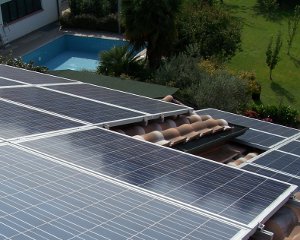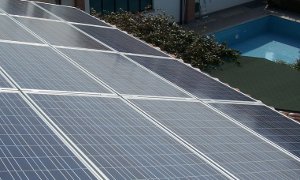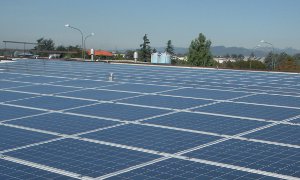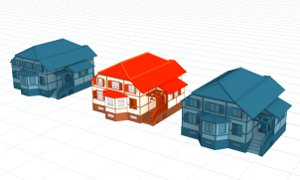on
off
Solar power
The solar power is associated to solar radiation and it is the primary source of power on the earth which makes life possible.
From this power, al least all the other power sources available for mankind (for example fossil fuels, wind power, wave power, hydroelectric power, biomass energy, except for geothermal energy and tidal power) derive more or less directly. It can be used for power purposes, in order to produce heat or electricity with different types of systems.
Technologies
The solar power can be used to produce electricity (photovoltaic system) or heat (solar thermal system). The most important technologies that are used to transform the solar power into exploitable power are:
- The solar thermal collector uses sun rays to heat up a liquid with special features, included within it, which makes over heat, through a heat exchanger, to the water included in a storage tank.
- The photovoltaic collector uses the particular properties of certain semiconductors to produce electricity when they are stimulated by the light.
- The concentrated solar power collector uses a series of parabolic mirrors with a linear structure to channel sun rays in a receiver tube, in which a heat transfer fluid flows, or a series of flat mirrors that direct rays to the edge of a tank in which there is a biomass boiler filling with salts which liquefy thanks to heat. In both cases, the receiver system heats up with high temperatures (400°C ~ 600°C) (solar thermodynamic system).
The solar thermal collector
The thermal collectors can be of natural circulation or forced circulation. The first ones use the liquid included in the panels to allow the circulation within the thermal collector system.
In this case the storage tank, which includes the heat exchanger, must be higher than the collector; the forced circulation systems use a pump that moves the fluid into the exchanger and the collector when the temperature of the fluid within the collector is higher than that within the storage tank, which, in this case, is further down than the collectors.
The systems of this type are the most complex from the point of view of controls and the employed equipments (pumps, temperature sensors, three-way valves, solar controllers), but they allow you to put the storage tank, even if it is big, almost where you want, for example on the floor and not on the roof, where problems of weight would complicate the arrangement.
The photovoltaic collector
The photovoltaic collectors directly transform the solar light into electricity. These collectors use the photoelectric effect and they have a conversion efficiency of 32,5% in laboratory cells.
Basically, once the collectors in the cells got obtained and assembled in the place, the efficiency, generally, is about 13-15% for crystalline silicon collectors and it does not reach 12% for thin-film collectors. The most efficient commercial products reach 19-20%, by using multiple junction/connection cells or positioning techniques of the electrical contacts on the back of the cell (backcontact).
These collectors need a little maintenance because they do not have moving parts: substantially, they only must be cleaned every now and then. The lifetime of the photovoltaic collectors is about 30 years.
The main defect of these systems is the cost of the collectors, the second defect is that the power is produced only during the day and so it is not suitable for any situation, being the electricity a form of power which is collected with difficulty in great quantity.
However, we have to say that the solar production is higher exactly in those moments of high request, that is to say during the day and the hot seasons, during which it can provide for the increasing consumptions due to ventilation and conditioning systems.
Uses
Nowadays, the solar collectors are used to supply hot water (solar thermal) and heating to houses and little housing estates. Some solar thermal energies that transform the stored heat into electricity (solar thermodynamic) by using turbines have been constructed, but these prototypes do not have great application, due to the low performance of these energies, the high non-manufacturing costs and the discontinuity of the electricity supply.
The photovoltaic collectors are used in solar systems in order to supply those systems far from the electricity grids (space probs, telephone repeaters...) or systems with very low power demands that a connection to the electricity grid would be uneconomical (luminous road sign, parking meters,...) and not organizationally appropriate. Obviously, these systems must have accumulators able to collect the electricity overproduced during the day in order to supply the systems during the night and the cloudy days.
The photovoltaic panels are also used in large systems connected to the net, although the power quantity distributed is variable both daily and seasonal and so it is foreseeable with difficulty and it cannot be programmed; this discontinuity makes the demand of electricity difficult to satisfy in every moment, unless there is a production safer than the annual peaks of demand. However, although the peak of production of the solar systems is in summer, the photovoltaic collectors manage to counterbalance the higher home demand due to air-conditionings.

Photovoltaic system (industrial warehouse)
Photovoltaic system for an industrial warehouse in Urgnano (Bergamo).




